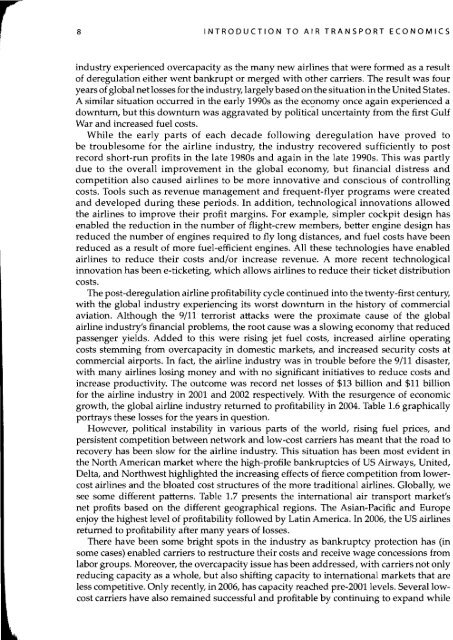The Evolving Air Transport Industry
The Evolving Air Transport Industry
The Evolving Air Transport Industry
- TAGS
- evolving
- komaristaya.ru
Create successful ePaper yourself
Turn your PDF publications into a flip-book with our unique Google optimized e-Paper software.
8<br />
INTRODUCTION TO AIR TRANSPORT ECONOMICS<br />
industry experienced overcapacity as the many new airlines that were formed as a result<br />
of deregulation either went bankrupt or merged with other carriers. <strong>The</strong> result was four<br />
years of global netlosses for the industry, largely based onthe situation inthe United States.<br />
A similar situation occurred in the early 1990s as the economy once again experienced a<br />
downturn, but this downturn was aggravated by political uncertainty from the first Gulf<br />
War and increased fuel costs.<br />
While the early parts of each decade following deregulation have proved to<br />
be troublesome for the airline industry, the industry recovered sufficiently to post<br />
record short-run profits in the late 1980s and again in the late 1990s. This was partly<br />
due to the overall improvement in the global economy, but financial distress and<br />
competition also caused airlines to be more innovative and conscious of controlling<br />
costs. Tools such as revenue management and frequent-flyer programs were created<br />
and developed during these periods. In addition, technological innovations allowed<br />
the airlines to improve their profit margins. For example, simpler cockpit design has<br />
enabled the reduction in the number of flight-crew members, better engine design has<br />
reduced the number of engines required to fly long distances, and fuel costs have been<br />
reduced as a result of more fuel-efficient engines. All these technologies have enabled<br />
airlines to reduce their costs and/or increase revenue. A more recent technological<br />
innovation has been e-ticketing, which allows airlines to reduce their ticket distribution<br />
costs.<br />
<strong>The</strong> post-deregulation airline profitability cycle continued into the twenty-first century,<br />
with the global industry experiencing its worst downturn in the history of commercial<br />
aviation. Although the 9/11 terrorist attacks were the proximate cause of the global<br />
airline industry's financial problems, the root cause was a slowing economy that reduced<br />
passenger yields. Added to this were rising jet fuel costs, increased airline operating<br />
costs stemming from overcapacity in domestic markets, and increased security costs at<br />
commercial airports. In fact, the airline industry was in trouble before the 9/11 disaster,<br />
with many airlines losing money and with no significant initiatives to reduce costs and<br />
increase productivity. <strong>The</strong> outcome was record net losses of $13 billion and $11 billion<br />
for the airline industry in 2001 and 2002 respectively. With the resurgence of economic<br />
growth, the global airline industry returned to profitability in 2004. Table 1.6 graphically<br />
portrays these losses for the years in question.<br />
However, political instability in various parts of the world, rising fuel prices, and<br />
persistent competition between network and low-cost carriers has meant that the road to<br />
recovery has been slow for the airline industry. This situation has been most evident in<br />
the North American market where the high-profile bankruptcies of US <strong>Air</strong>ways, United,<br />
Delta, and Northwest highlighted the increasing effects of fierce competition from lowercost<br />
airlines and the bloated cost structures of the more traditional airlines. Globally, we<br />
see some different patterns. Table 1.7 presents the international air transport market's<br />
net profits based on the different geographical regions. <strong>The</strong> Asian-Pacific and Europe<br />
enjoy the highest level of profitability followed by Latin America. In 2006, the US airlines<br />
returned to profitability after many years of losses.<br />
<strong>The</strong>re have been some bright spots in the industry as bankruptcy protection has (in<br />
some cases) enabled carriers to restructure their costs and receive wage concessions from<br />
labor groups. Moreover, the overcapacity issue has been addressed, with carriers not only<br />
reducing capacity as a whole, but also shifting capacity to international markets that are<br />
less competitive. Only recently, in 2006, has capacity reached pre-2001Ievels. Several lowcost<br />
carriers have also remained successful and profitable by continuing to expand while


